This morning, I read an article in the Telegraph about the "Latitude Festival," an annual music festival that takes place in Suffolk, England. The first one was in 2006. The article in the Telegraph isn't about the music. Instead, Neil McCormick describes the people and setting. Here's what caught my eye:
People enter into the spirit with colourful costumes: there were parties of American Indians, Smurfs and an engaging posse of pensionable old dears dressed as fairies. The audience is, it has to be said, overwhelmingly white and middle-class (and probably predominantly middle-aged).
Indians, Smurfs, and fairies.
Reading those words reminded me of an email I received on December 30, 2007 in response to critiques I posted about one of Jan Brett's books. In her email, the author wrote:
Why is there always someone who wants to rain on someone else's parade? Why can't children just enjoy a good read? I am sure you don't believe in Santa, the tooth fairy or the Easter bunny because they are incorrect in guiding young children's beliefs.
For those that want to study the American Indian ways and beliefs, good for them. For now I will read and enjoy books, just because.
It struck me that she would cast American Indians in that particular framework---of things-not-real. She is a librarian in a public school in Raleigh, North Carolina.
Santa. The Tooth Fairy. The Easter Bunny.
Indians, Smurfs, and fairies.
Here and in the UK. Evidence of the work that needs doing, and I note with no small amount of concern, the librarians
resistance to that work.
To see what prompted the librarian's email, read Theresa Seidel's "
An Open Letter to Jan Brett, published here on December 19, 2007. And read a related article
"Jan Brett and Sherman Alexie" posted here on December 31, 2007.
Yesterday, a comment was submitted to "Jan Brett and Sherman Alexie" posted here on December 31, 2007. In that post, I compared Brett's The Three Snow Bears to Alexie's The Absolutely True Diary of a Part-Time Indian. Both were on the New York Times best seller list. Brett's book objectifies and dehumanizes American Indians; Alexie's book does not. In his book, readers come to know the life of a Native teen, with its ups and downs, its richness and its hardships. Beautiful, brutual, honest.
Teresa (the person who submitted the comment yesterday) did not like the critique of Brett's book. Here's what she said:
You mention, "in The Three Snow Bears, we have another book in which an author/illustrator puts Native clothing on animals, effectively de-humanizing American Indians." Animals and cartoon characters are constantly pictured in clothing worn by Americans of all races. I don't feel dehumanized by animals in children's books wearing jeans and t-shirts. Nor do I think you would even blink if you saw a book in which animals were dressed in traditional European, African, or Asian clothing. I'm a big fan of Sherman Alexie's books and also of Jan Brett's beautiful illustrations. Your over-sensitivity loses me here.
Her comments reflect how difficult it is to recognize subtle forms of racism. I hasten to say that I don't think Teresa is racist. She is not able to see what I am trying to help her see, but that does not mean she is racist.
This morning in ScienceDaily I read an article about a study on subtle discrimination that may help understand why it is hard for some to see problematic depictions of American Indians as inappropriate or hurtful. The article is called
"Racism's Cognitive Toll: Subtle Discrimination is More Taxing on the Brain." It summarizes research done by Jessica Salvatore and J. Nicole Shelton, two psychologists at Princeton. Here's a couple of key excerpts:
The problem is that we have limited cognitive resources, so when we are solving one problem, we have difficulty focusing on another at the same time. Some psychologists reason from this that subtle racism might actually be more, not less, damaging than the plain antipathy of yesterday, sapping more mental energy. Old-fashioned racism--a "No Negroes Allowed" sign, for example--is hateful and hurtful, but it's not vague or confusing. It doesn't require much cognitive work to get it. But if you're the most qualified candidate for a job, and know it, and still don't get the job for some undisclosed reason--that demands some processing.
That last line, about being qualified for a job, points to the research study itself. Participants in the study were either black or white. The researchers created a situation in which participants observed fair and unfair hiring decisions and then took the Stroop test that tests capacity for mental effort. Salvatore and Shelton's research question was to see if experiencing subtle racism interfered with mental capacity:
It did, at least for blacks, and more than the overt racism did. As reported in the September issue of Psychological Science, black volunteers who had witnessed unfair but ambiguous hiring decisions did much less well on the Stroop test, suggesting that they were using all their mental resources to make sense of the unfairness.
Interestingly, white volunteers were more impaired by overt racism than by the more ambiguous discrimination. Salvatore and Shelton figure this is because whites rarely experience any racism; they do not even notice the subtle forms of racism, and are thrown off balance when they are hit over the head by overt acts. Many blacks, by contrast, have developed coping strategies for the most hateful kinds of racism; it's the constant, vague, just-below-the-surface acts of racism that impair performance, day in and day out.
So. Let's go back to Teresa's comment, and let's think about children in classrooms, observing racism in books, classroom materials, etc.
Teresa can't see the problems in Jan Brett's book. It takes work to subtle forms of racism. Again, this is not an attack on Teresa. Her comments are representative of a lot of people (I'd say the majority of people) who resist critiques like those found on this site.
Racism, whether it is overt or subtle, is costing us in ways we may not realize. Research studies like the one by Salvatore and Shelton may help us revisit and rethink our views about books like
The Three Snow Bears.
What does this mean for the classroom?
A lot of people argue that we should teach books like
Little House on the Prairie because it allows us to talk about attitudes people had "at that time." I think that is a good use of the book, but only with students who are much older. I suggest that book be read in high school and college, not elementary school. And I will also note that the majority of lesson plans on LHOP do not address the racist attitudes in the book.
I do wonder, though, if upon the conclusion of a discussion of LHOP, the Stroop test were given, how the students would fare?
UPDATE, MARCH 31, 2009 - 4:30 CSTMitali Perkins has an article about race in the April issue of
School Library Journal. Anticipating push-back on her article, she
blogged about it today, referencing my post. If her article is accessible online, I'll link to it here.
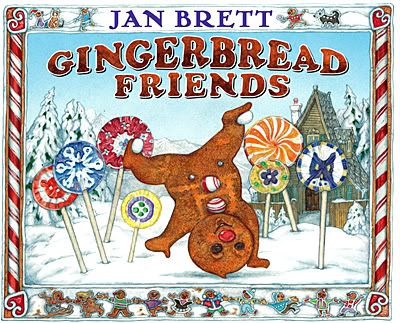
GINGERBREAD FRIENDS by Jan Brett (Putnam, 2008),
Picture Book, ages 4-8, 32 pp. On shelves now.
Mmmmm!! Look what just popped out of the oven -- Gingerbread Friends, a freshly-baked sequel to Jan Brett's scrumptious 1999 book, Gingerbread Baby.
Yes! That sassy, cocky little cookie baby is back for another adventure. We last saw him safely tucked away in a little gingerbread house made especially for him by his creator, Mattie. Though surrounded by lots of treats and toys, the Gingerbread Baby is lonely when Mattie goes off to ski and skate with his friends.
So, the next day, when Mattie is busy in the kitchen, the Gingerbread Baby decides to pop on over to the village to find some friends of his own. There, he sees a man and woman just his size in the bakery window. Although he sings and dances for them, they won't move or even look at him. Undaunted, the Gingerbread Baby approaches a Sugar Cookie Girl and tries to win her over with his song:
I'm the Gingerbread Baby,
Gallant as can be,
I'll be friends with you,
If you'll be friends with me.
But she, too, remains stiff and silent. His efforts to similarly befriend some swans and a couple dancing atop a mountainous cake are equally fruitless, so he ends up running through a little door just his size and falls asleep. He is rudely awakened by the strange sensation of someone nibbling on his marshmallow pom pom. A cheeky mouse! A frantic chase ensues, involving a cat, the baker, his wife, and a fox! Can the Gingerbread Baby escape with his life once again?
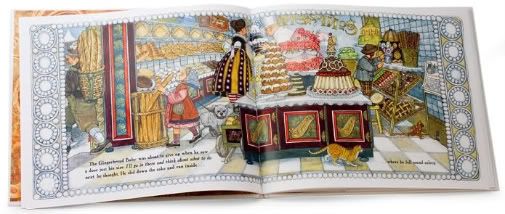
Set in a snow-luscious Swiss mountainside village, Gingerbread Friends will satisfy your holiday sweet tooth with its delectable, lick-the-page watercolor and gouache illustrations, all rendered in Brett's intricate, detailed trademark style. The spreads featuring all the bakery confections -- breads, cakes, pies, mountains of cookies and candies, can only be described as "an ultimate feast for the eyes." The side borders depict an equally delicious subplot -- Mattie is shown busy in the kitchen, baking -- well, I won't tell you what and spoil the ending, but trust me, the fruits of his labor delightfully explode in a final giant foldout page.
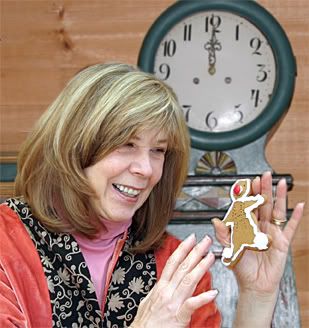
Brett has said that it takes her an hour to draw an inch, and her brilliant work is proof of the pudding. Young readers will have a ball poring over the pictures, which serve up new details with each glance. I love the spread of the Gingerbread Baby outside the bakery -- a tiny cookie person at a big blue door, and of course the gingerbread side borders, featuring recipe ingredients framed in frosted hearts, which inspire unabashed drooling every time, as it effectively hints at the ending and revs up anticipation.
For those of you who haven't yet visited Jan Brett's website, prepare to be amazed. It contains 4,696 (gasp!) pages, filled not only with book information, but activities (placemats, puzzles, signs, labels, drawing lessons, on and on), coloring pages, home and school projects, videos, games, and the occasional contests. To extend your enjoyment of Gingerbread Friends, you can create and print out your own greeting cards and envelopes, make a 2009 calendar, construct a 3 x 6 foot mural, or even design your own gingerbread friend. Loads of holiday and year-round fun for all ages, a real internet treasure trove that gives new meaning to the term, "interactive."
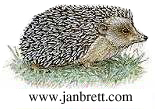
*If you somehow missed Gingerbread Baby, be sure to watch this video with Jan reading the story to several children. They're even munching on gingerbread men cookies while listening to her. Man, I love the smell of gingerbread baking in the kitchen (Jan says her studio smelled like gingerbread for an entire year while she was working on this book).
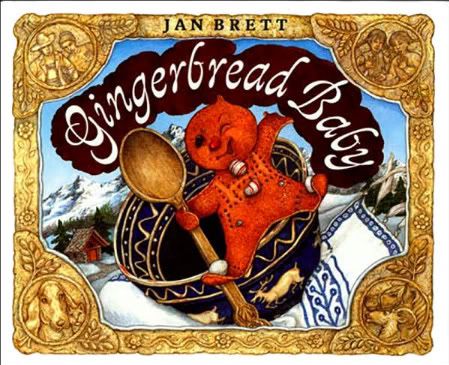
You can find Jan's recipe for gingerbread babies here. Grab it before it gets away from you!
Don't miss this fun interview where she answers questions posed by students and teachers.
Also, from Scholastic, a great Author Study page, featuring lessons based on many of her other books.
For my tasty tidbit of a post about the history of gingerbread, gingerbread men stories, and my personal favorite gingerbread men recipe, click here.

This is the perfect time of year to create a tasty gingerbread house. HIGHLIGHTSKIDS.COM has this cool online site. Now gingerbread house fans can make one without any of the mess.
Or you might want to read some other gingerbread tales. For a new twist on the story, try
THE GINGERBREAD COWBOY by Janet Squire. You can probably find a copy at your local library or bookstore.
But if you are ready to make a real gingerbread house, find a book like Jennifer A. Ericsson's
GINGERBREAD HOUSES FOR KIDS and start creating.









Just back from England...so, sadly, not surprised. Every story had to begin with a story from an older friend: "If you visited me, I would offer you a chair and share my food--but would not expect you to take the chair and empty the frig when you left!" Saw too many cedar flutes being carried about by Anglo-Saxons---and djimbe drums played by pale-skinned "pagans"....Ah, the work that needs doing...
"Evidence of the work that needs doing, and I note with no small amount of concern, the librarians resistance to that work."
It is NOT a librarian's job to censor books. I applaud the job you do educating the public, but public libraries are NOT sanctuaries of truth and fact. We pride ourselves on diverse collections representing many different points of view. We are doing a different job than you are, and that is ok. Keep up the good work, but don't expect public libraries to become repositories of only PC items.
Hi Anonymous,
The librarian who wrote to me works at a school, not in a public library. I know about the ALA Bill of Rights.
My remark about resistance has more to do with that librarian's attitude than a discussion of censorship or selection.
She seems very close-minded to learning about American Indians, and to considering a viewpoint that counters her own.
I keep meaning to send you this article I read in the May/June 2009 Utne Reader: Der Indianer: Why do 40,000 Germans spend their weekends dressed as Native Americans?
In response to that Utne article posted by Saints and Spinners - in the current (July-August 2009)issue there is an interesting (especially in light of what Debbie is doing) letter to the editor (bold is mine):
"I grew up in Romania, and when I was 10 years old Karl May's novels about Winnetou and Old Shatterhand were the bomb. There were also some spin-offs that I remember (plus cartoons galore). I now live in Oconee County, South Carolina. While my childhood memories still uphold these heroes, my adoptive country has shown me that everything I knew about Native Americans since childhood was wrong, the product of a writer's imaginative mind. Florin D. Lung Seneca, South Carolina.
Regarding the quote Carys mentioned -- that reminded me of one time when a Romanian visited us when I was a kid. I can't remember the whole incident, but the gentleman asked my dad if they could go see Indians; the assumption was that they would go to a reservation, perhaps, and see people as they would have lived 100+ years ago, except he didn't realize that they don't live that way anymore, in the same way that my family no longer herds sheep and practices transhumance.
The man was also very surprised that Indians weren't everywhere (or, I suppose, visibly evident everywhere).
At the time, I attributed it to many people just not having a good knowledge of the US before coming here (any more than most Americans would of Romania); we'd also had visitors who had no concept of the large distances in the US, so they thought they could go visit their friends in Seattle (we were in Massachusetts) by bus, not realizing that it would take days.
Definitely a case of "everything but the burden" mixed with romanticization of the "lost" and the noble savage trope. I can understand why humans want to get all romantic about nostalgia but the love of that romantic totally false past rarely connected to any passion for the state of the actual people in the actual present. Their love of the supposed "beauty of the romanticized pagan past" can't allow the real and the true to intrude. Perhaps they dismiss reality because it's too bothersome and can't really be played with as they frolic along trying to find their lost mythic inner child. Great post. -C